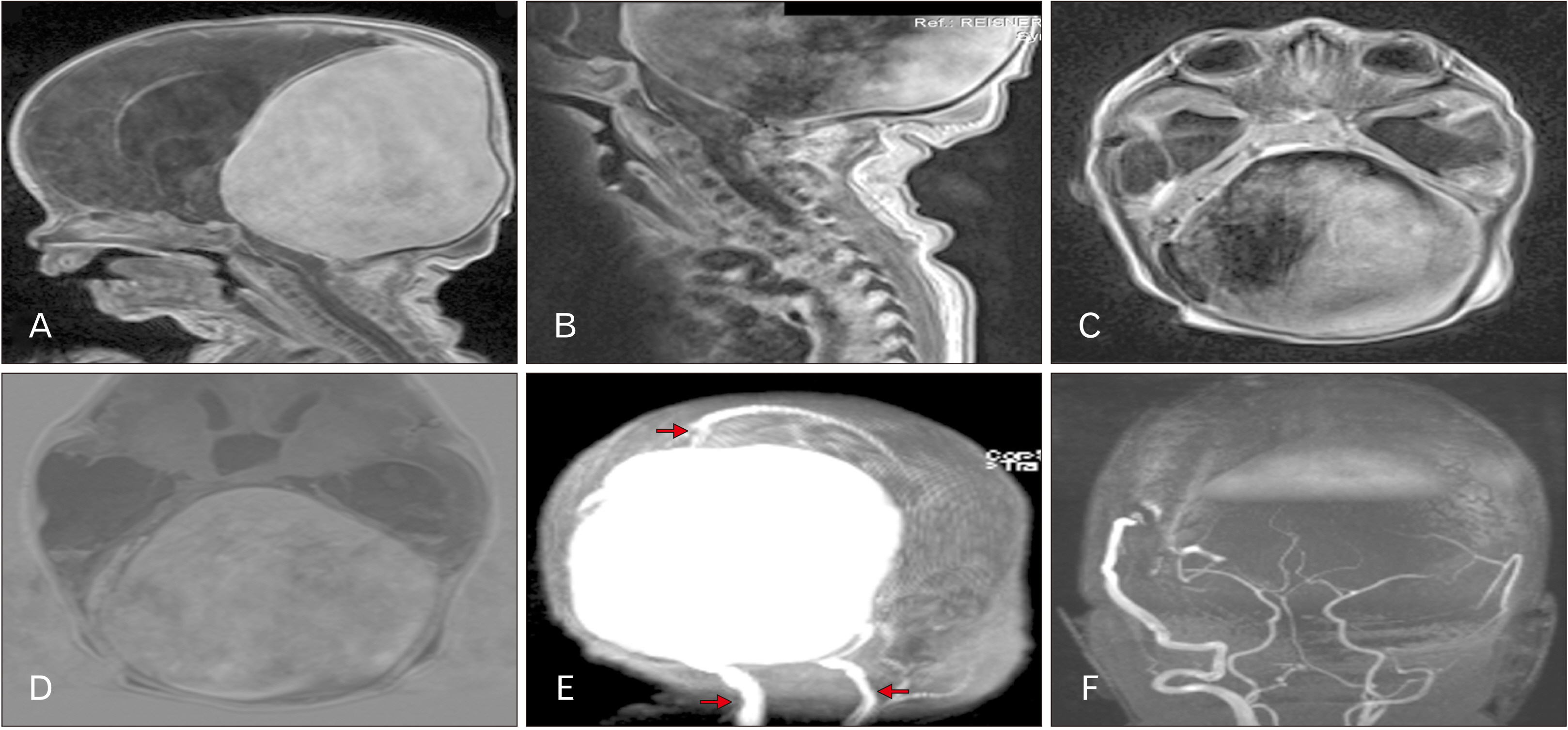Anat Cell Biol.
2021 Dec;54(4):518-521. 10.5115/acb.21.083.
Giant dural arteriovenous fistula in an infant
- Affiliations
-
- 1Department of Neurosurgery, Tulane Center for Clinical Neurosciences, Tulane University School of Medicine, New Orleans, LA, USA.
- 2Department of Neurology, Tulane Center for Clinical Neurosciences, Tulane University School of Medicine, New Orleans, LA, USA.
- 3Department of Structural & Cellular Biology, Tulane University School of Medicine, New Orleans, LA, USA.
- 4Department of Neurosurgery and Ochsner Neuroscience Institute, Ochsner Health System, New Orleans, LA, USA.
- 5Department of Anatomical Sciences, St. George's University, St. George's, Grenada.
- 6Department of Surgery, Tulane University School of Medicine, New Orleans, LA, USA.
- KMID: 2523581
- DOI: http://doi.org/10.5115/acb.21.083
Abstract
- Dural arteriovenous fistulas (dAVFs) are commonly encountered by the neurosurgeon. Herein, we present a case illustration of an infant presenting with an extremely large fistula that took up a significant part of the intracranial volume. A one-month-old female presented with irritability and failure to thrive. She was the product of a 35-week pregnancy and was delivered vaginally without complications or a difficult labor. Based on the findings of magnetic resonance imaging, the diagnosis of a giant dAVF involving the transerve-sigmoid sinuses was made. The patient was scheduled for an arteriogram but died before the procedure could be performed. Such a case illustrates how large some dAVF can become and at a very early age. As in the present case, the patient was minimally symptomatic. Therefore, the time to intervention after diagnosis is thus, sometimes, critical.
Figure
Reference
-
References
1. Li Q, Zhang Q, Huang QH, Fang YB, Zhang ZL, Xu Y, Liu JM. 2014; A pivotal role of the vascular endothelial growth factor signaling pathway in the formation of venous hypertension-induced dural arteriovenous fistulas. Mol Med Rep. 9:1551–8. DOI: 10.3892/mmr.2014.2037. PMID: 24626343. PMCID: PMC4020488.
Article2. Xu K, Yang X, Li C, Yu J. 2018; Current status of endovascular treatment for dural arteriovenous fistula of the transverse-sigmoid sinus: a literature review. Int J Med Sci. 15:1600–10. DOI: 10.7150/ijms.27683. PMID: 30588182. PMCID: PMC6299407.
Article3. Cognard C, Gobin YP, Pierot L, Bailly AL, Houdart E, Casasco A, Chiras J, Merland JJ. 1995; Cerebral dural arteriovenous fistulas: clinical and angiographic correlation with a revised classification of venous drainage. Radiology. 194:671–80. DOI: 10.1148/radiology.194.3.7862961. PMID: 7862961.
Article4. Borden JA, Wu JK, Shucart WA. 1995; A proposed classification for spinal and cranial dural arteriovenous fistulous malformations and implications for treatment. J Neurosurg. 82:166–79. DOI: 10.3171/jns.1995.82.2.0166. PMID: 7815143.
Article5. Adamczyk P, Amar AP, Mack WJ, Larsen DW. 2012; Recurrence of "cured" dural arteriovenous fistulas after Onyx embolization. Neurosurg Focus. 32:E12. DOI: 10.3171/2012.2.FOCUS1224. PMID: 22537121. PMCID: PMC4085989.
Article6. Dawson RC 3rd, Joseph GJ, Owens DS, Barrow DL. 1998; Transvenous embolization as the primary therapy for arteriovenous fistulas of the lateral and sigmoid sinuses. AJNR Am J Neuroradiol. 19:571–6. PMID: 9541321. PMCID: PMC8338260.7. Piechowiak E, Zibold F, Dobrocky T, Mosimann PJ, Bervini D, Raabe A, Gralla J, Mordasini P. 2017; Endovascular treatment of dural arteriovenous fistulas of the transverse and sigmoid sinuses using transarterial balloon-assisted embolization combined with transvenous balloon protection of the venous sinus. AJNR Am J Neuroradiol. 38:1984–9. DOI: 10.3174/ajnr.A5333. PMID: 28818827. PMCID: PMC7963627.
Article8. Giller CA, Barnett DW, Thacker IC, Hise JH, Berger BD. 2008; Multidisciplinary treatment of a large cerebral dural arteriovenous fistula using embolization, surgery, and radiosurgery. Proc (Bayl Univ Med Cent). 21:255–7. DOI: 10.1080/08998280.2008.11928405. PMID: 18628973. PMCID: PMC2446414.
Article9. Reynolds MR, Lanzino G, Zipfel GJ. 2017; Intracranial dural arteriovenous fistulae. Stroke. 48:1424–31. DOI: 10.1161/STROKEAHA.116.012784. PMID: 28432263. PMCID: PMC5435465.
Article10. Friedman JA, Pollock BE, Nichols DA, Gorman DA, Foote RL, Stafford SL. 2001; Results of combined stereotactic radiosurgery and transarterial embolization for dural arteriovenous fistulas of the transverse and sigmoid sinuses. J Neurosurg. 94:886–91. DOI: 10.3171/jns.2001.94.6.0886. PMID: 11409515.
Article11. Mullan S, Mojtahedi S, Johnson DL, Macdonald RL. 1996; Embryological basis of some aspects of cerebral vascular fistulas and malformations. J Neurosurg. 85:1–8. DOI: 10.3171/jns.1996.85.1.0001. PMID: 8683257.
Article12. Kaushik KS, Acharya UV, Ananthasivan R, Girishekar B, Reddy P. 2020; Fetal dural sinus malformation. Neurology. 95:452–3. DOI: 10.1212/WNL.0000000000010446. PMID: 32753437.
Article
- Full Text Links
- Actions
-
Cited
- CITED
-
- Close
- Share
- Similar articles
-
- Endovascular Treatment of Dural Sinus Malformation in Infant: A Case Report
- Endovascular Treatment of Spinal Dural and Epidural Arteriovenous Fistula as Complication of Lumbar Surgery
- Stereotactic radiosurgery for dural arteriovenous fistula
- A Case of Dural Arteriovenous Fistula of the Anterior Condylar Vein
- Occurrence of Metachronous Intracranial Dural Arteriovenous Fistula after Embolization of Intracranial Dural Arteriovenous Fistula: A Case Report


